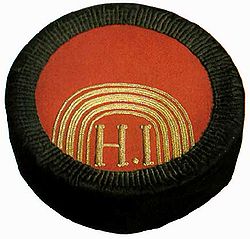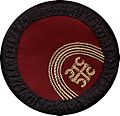| Revision as of 11:10, 1 June 2007 editPaulcicero (talk | contribs)1,005 edits rv, discuss if you have a problem with the article← Previous edit | Latest revision as of 19:17, 5 November 2024 edit undoMonkbot (talk | contribs)Bots3,695,952 editsm Task 20: replace {lang-??} templates with {langx|??} ‹See Tfd› (Replaced 1);Tag: AWB | ||
| (141 intermediate revisions by 77 users not shown) | |||
| Line 1: | Line 1: | ||
| {{italic title|noerror|all=yes}} | |||
| ⚫ | |||
| {{Infobox|title = Montenegrin cap<br><small>''Црногорска капа''</small> | |||
| ] | |||
| |image = ] | |||
| ⚫ | |||
| |caption = A Montenegrin cap with the initials ''N.I.''of King ] | |||
| The '''Montenegrin cap''' (]: Црногорска капа or ''Crnogorska kapa'') is a ] ]ally worn by ]. | |||
| |captionstyle = | |||
| }} | |||
| The '''Montenegrin cap''' ({{langx|sr|Црногорска капа|Crnogorska kapa}}) is a ] traditionally worn in ] by the ] and ]. It was introduced by Prince Bishop ] in the mid-1840s as a replacement for the then-popular ].<ref name="Roudometof2001">{{cite book|author=Victor Roudometof|title=Nationalism, Globalization, and Orthodoxy: The Social Origins of Ethnic Conflict in the Balkans|url=https://books.google.com/books?id=I9p_m7oXQ00C&pg=PA128|year=2001|publisher=Greenwood Publishing Group|isbn=978-0-313-31949-5|page=128}}</ref> | |||
| ==Design and symbolism== | |||
| The cap is in the shape of a flat ], having a red upper surface (called ''tepelak'') surrounded by a ] rim (called ''derevija''). One part of the ''tepelak'' is surrounded with five golden threads, with the center of the surrounded surface being adorned, often with a ], though there are other variations: the wearer's ], initials of the wearer's region (]), a ruler's initials (today often Н. I, the initials of the last Montenegrin king ]), the ] or even the ]. The last two can fill the entire ''tepelak'', in which case there are no surrounding threads. | |||
| ] donning the Montenegrin cap he popularized]] | |||
| The cap is originally in the shape of a flat ], having a red upper surface (called ''tepelak'') not dissimilar to the ] and ]s. Prince-Bishop ] wore it with a ] rim (called ''derevija''),<ref>{{citation|author=Vuk Stefanović Karadžić|title=Crna Gora i Crnogorci|year=1837|publisher=Rastko|url=http://www.rastko.rs/knjizevnost/vuk/vkaradzic-crnagora.html}}</ref> and the definition given was as a sign of grief of occupied ]. The ] was very popular in Montenegro. The enforcement of the cap upon the Montenegrin chieftains by Prince-Bishop Petar II was a mark of expression of then's dominating ].<ref>{{citation|author=Miodrag Vlahović|title=O najstarijoj kapi kod jugoslovena s obzirom na zbirku kapa etnografskog muzeja u Beogradu|work=Glasnik Etnografskog muzeja u Beogradu|year=1953|location=Belgrade|publisher=Etnografski Muzej}}</ref> | |||
| The national telling recorded the most often version of the cap as following: the black wrapper was a sign of grief for their ], the red the symbol of spilled blood at the ]<ref>{{citation|author=Andrija Jovićević|title=Crna Gora, Narodni život i običaji|year=1903}}</ref> and the five small stripes on the top represent the remaining remains of the once great Serbian realm,<ref>{{citation|author=Zorica Radulović|title=Crnogorska muška kapa|work=Glasnik Cetinjskih muzeja IX|year=1976|location=Cetinje}}</ref> which became increasingly popular amongst the common folk during the reign of Prince ]. Within the stripes is angled a six star, representing the last free part, Montenegro, shining upon the fallen and conquered.<ref>{{citation|author=Jovan Vukmanović|title=Fizicki lik i izgled Njegosa|work=Glasnik Etnografskog muzeja na Cetinju|location=Cetinje|year=1963}}</ref> | |||
| The Montenegrin cap is somewhat similar to the ]; also, similarity is noted to the hat which was traditionally worn in ]. Its final design, which survives until today, was done by the famous Montenegrin ruler and poet ] , who also ascribed ] to it: the red color of the ''tepelak'' symbolises the ] of people who have fallen for freedom (Fallen Serbs of the ]) , the black symbolises sorrow for lost freedom (when Ottoman Turkey conquered ]), and five golden threads symbolise the five centuries spent under ]. | |||
| During the ] in the second half of the 20th century instead of the ] the Communist ] was implanted between the golden stripes, although it was not spread amongst the people and never accepted. Several years ago a new version appeared with a large modern (2004) ] spread across the cap's red top, that is becoming increasingly popular as a sign of the Montenegrin nation's independence and sovereignty. A female version of the cap was introduced, so far worn almost exclusively by men.{{citation needed|date=February 2015}} | |||
| Through history, it was called by different names: ''valjana'', ''bijela'', ''kariklija'', ''zavratka''. Today it is called simply "montenegrin cap" (''crnogorska kapa''). | |||
| ==History== | |||
| The Montenegrin cap has a three-hundred-year history. A 1754 portrait of a Montenegrin from ] is the oldest representation of the Montenegrin cap, with the Paštrovići variant of the cap being all-black in color. The first representation of the cap in its modern, two-colour variety (black and red) is found on an aquarelle from 1782.<ref>Slobodan B. Medojević, Crnogorska Kapa, https://issuu.com/vijececg/docs/cg_glasnik_84 #page=52-53</ref> ], on his journey through Montenegro in 1876, described a Montenegrin cap and its eagle motif.<ref> Mladen Zadrima, 2019, Crnogorska narodna nošnja kroz opise stranih putopisaca http://www.maticacrnogorska.me/files/78/21%20mladen%20zadrima%2078.pdf #page=389</ref> | |||
| ==Gallery== | |||
| <gallery> | |||
| Image:Montenegrin priest before battle.jpg|A Montenegrin ] Priest before battle wearing his cap, 1876 | |||
| Image:11 Monteneginer.jpg|Montenegrin man, 19th Century | |||
| Image:Montenegrin officers in national costumes, R. Wyon (1904).jpg|Officers of the ] wearing their caps, 1904 | |||
| ⚫ | Image:Montenegrin cap.jpg|Montenegrin cap with the ] | ||
| ⚫ | Image:Montenegrin caps of Queen Milena and King Nikola.jpg|These richly adorned caps were worn by King ] (right) and his queen, ] | ||
| </gallery> | |||
| ==See also== | ==See also== | ||
| * ] | |||
| * ] | |||
| * ] | * ] | ||
| ==References== | |||
| ⚫ | ] | ||
| {{Reflist}} | |||
| ⚫ | ] | ||
| {{Hats}} | |||
| ] | |||
| {{DEFAULTSORT:Montenegrin Cap}} | |||
| ⚫ | ] | ||
| ⚫ | ] | ||
| ] | |||
| ] | |||
| ] | |||
| ] | |||
| ] | |||
| ] | |||
Latest revision as of 19:17, 5 November 2024
 A Montenegrin cap with the initials N.I.of King Nicholas I of Montenegro A Montenegrin cap with the initials N.I.of King Nicholas I of Montenegro |
The Montenegrin cap (Serbian: Црногорска капа, romanized: Crnogorska kapa) is a cap traditionally worn in Montenegro by the Montenegrins and Serbs of Montenegro. It was introduced by Prince Bishop Petar II Petrović-Njegoš in the mid-1840s as a replacement for the then-popular fez.
Design and symbolism

The cap is originally in the shape of a flat cylinder, having a red upper surface (called tepelak) not dissimilar to the Herzegovina and Lika caps. Prince-Bishop Petar II Petrović-Njegoš wore it with a black rim (called derevija), and the definition given was as a sign of grief of occupied Kosovo. The Kosovo Myth was very popular in Montenegro. The enforcement of the cap upon the Montenegrin chieftains by Prince-Bishop Petar II was a mark of expression of then's dominating Serbian national identity.
The national telling recorded the most often version of the cap as following: the black wrapper was a sign of grief for their once great Serbian Empire, the red the symbol of spilled blood at the Battle of Kosovo and the five small stripes on the top represent the remaining remains of the once great Serbian realm, which became increasingly popular amongst the common folk during the reign of Prince Danilo I Petrović-Njegoš. Within the stripes is angled a six star, representing the last free part, Montenegro, shining upon the fallen and conquered.
During the Communist era in the second half of the 20th century instead of the Serb cross the Communist Red Star was implanted between the golden stripes, although it was not spread amongst the people and never accepted. Several years ago a new version appeared with a large modern (2004) Coat of Arms of Montenegro spread across the cap's red top, that is becoming increasingly popular as a sign of the Montenegrin nation's independence and sovereignty. A female version of the cap was introduced, so far worn almost exclusively by men.
History
The Montenegrin cap has a three-hundred-year history. A 1754 portrait of a Montenegrin from Paštrovići is the oldest representation of the Montenegrin cap, with the Paštrovići variant of the cap being all-black in color. The first representation of the cap in its modern, two-colour variety (black and red) is found on an aquarelle from 1782. Josef Holeček, on his journey through Montenegro in 1876, described a Montenegrin cap and its eagle motif.
Gallery
-
 A Montenegrin Orthodox Priest before battle wearing his cap, 1876
A Montenegrin Orthodox Priest before battle wearing his cap, 1876
-
 Montenegrin man, 19th Century
Montenegrin man, 19th Century
-
 Officers of the Royal Montenegrin Army wearing their caps, 1904
Officers of the Royal Montenegrin Army wearing their caps, 1904
-
 Montenegrin cap with the Serbian cross
Montenegrin cap with the Serbian cross
-
 These richly adorned caps were worn by King Nikola I (right) and his queen, Milena Vukotić
These richly adorned caps were worn by King Nikola I (right) and his queen, Milena Vukotić
See also
References
- Victor Roudometof (2001). Nationalism, Globalization, and Orthodoxy: The Social Origins of Ethnic Conflict in the Balkans. Greenwood Publishing Group. p. 128. ISBN 978-0-313-31949-5.
- Vuk Stefanović Karadžić (1837), Crna Gora i Crnogorci, Rastko
- Miodrag Vlahović (1953), "O najstarijoj kapi kod jugoslovena s obzirom na zbirku kapa etnografskog muzeja u Beogradu", Glasnik Etnografskog muzeja u Beogradu, Belgrade: Etnografski Muzej
- Andrija Jovićević (1903), Crna Gora, Narodni život i običaji
- Zorica Radulović (1976), "Crnogorska muška kapa", Glasnik Cetinjskih muzeja IX, Cetinje
- Jovan Vukmanović (1963), "Fizicki lik i izgled Njegosa", Glasnik Etnografskog muzeja na Cetinju, Cetinje
- Slobodan B. Medojević, Crnogorska Kapa, https://issuu.com/vijececg/docs/cg_glasnik_84 #page=52-53
- Mladen Zadrima, 2019, Crnogorska narodna nošnja kroz opise stranih putopisaca http://www.maticacrnogorska.me/files/78/21%20mladen%20zadrima%2078.pdf #page=389